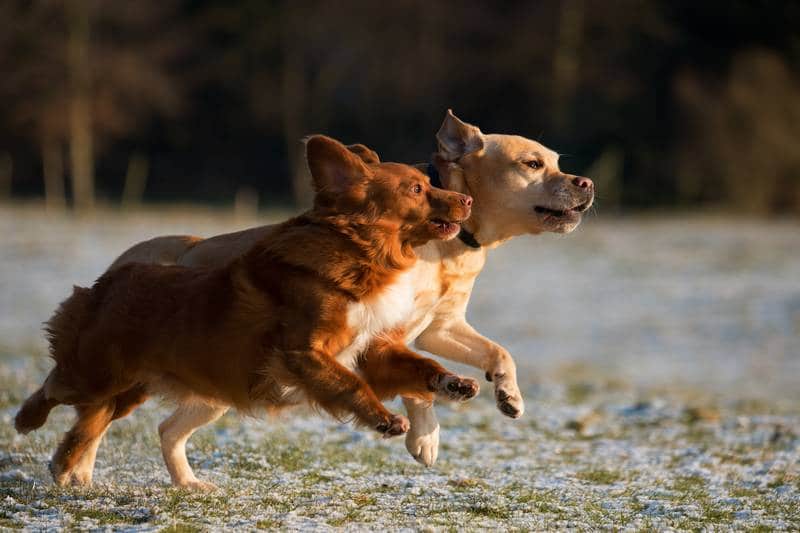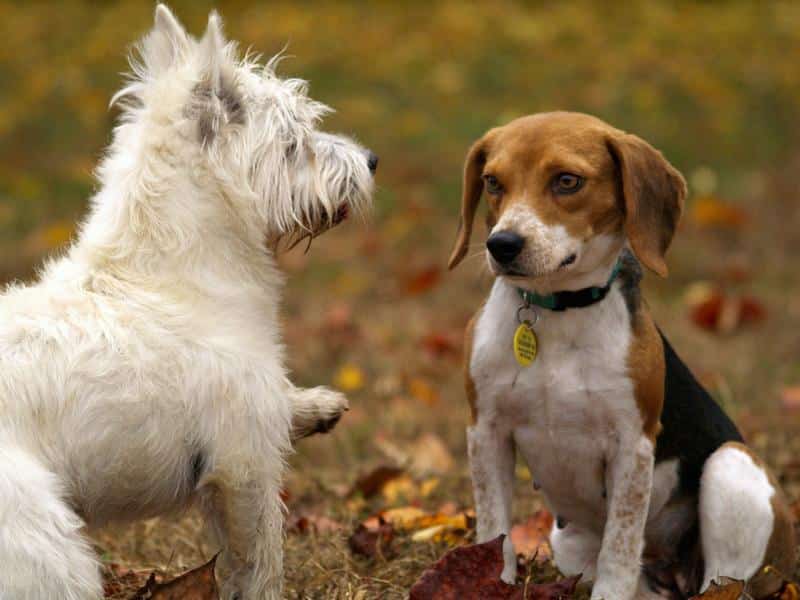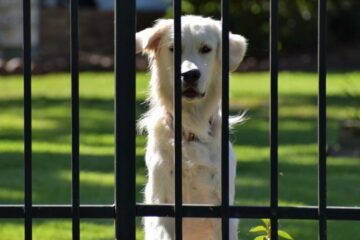My Dog Is Obsessed With My Other Dog! (What Do I Do?)
Is your dog overly attached or obsessed with your other dog? This behavior can be puzzling, but you’re not alone. Many pet owners face similar challenges.
In this article, we’ll take a look at why a dog might become obsessed with another dog, whether it’s your own or someone else’s. We’ll also cover special circumstances like male dogs obsessing over other males or males obsessing over females. For those who have recently noticed a sudden change in their dog’s behavior towards their furry housemate, we’ll offer some possible explanations too.
We will talk about the issue of codependency among dogs and what you can do about it. And if it’s a puppy that’s become fixated on other dogs, we’ve got that covered too! Keep reading below!
Dog Obsessed With Other Dog: How to Stop

If your dog is obsessed with another dog, it can be challenging to manage their behavior and ensure things stay peaceful. Let’s go over some strategies you can try to help redirect your dog’s focus and reduce their obsession.
- Identify the underlying cause: Understanding why your dog is fixated on the other dog is essential in addressing the behavior. It could be due to fear, lack of socialization, resource guarding, or a desire for attention. Identifying the root cause will guide your approach in resolving the issue.
- Manage the environment: If your dog becomes overly fixated on a specific dog, it may be best to limit their interactions. Avoid situations where they constantly encounter the dog, as this can reinforce their obsession. Create physical boundaries or use visual barriers to help redirect your dog’s attention.
- Increase mental and physical exercise: A dog with excessive energy or boredom is more likely to fixate on other dogs. Provide ample physical exercise through regular walks, play sessions, and interactive toys. Mental stimulation, such as puzzle toys or training exercises, can also help redirect their focus and tire them out.
- Focus on obedience training: Engaging in obedience training can help redirect your dog’s attention and improve their responsiveness to commands. Teach them commands like “sit,” “stay,” and “leave it,” and reinforce these behaviors consistently. Redirect their focus to you and reward them for following commands.
- Desensitization and counterconditioning: If your dog’s obsession stems from fear or anxiety, desensitization and counterconditioning techniques can be effective. Gradually expose your dog to the presence of the other dog at a distance, rewarding calm behavior and gradually decreasing the distance over time.
- Positive reinforcement: Reward your dog for calm and appropriate behavior around other dogs. Use treats, praise, or playtime to reinforce their good behavior and create positive associations with other dogs.
Remember that while these steps will get your dog to stop being obsessed with another dog, the underlying behavioral issue (anxiety, poor socialization, etc.) that was causing all of this to begin with will still be present. And until you address that, any positive changes you see are only going to be temporary.
“Well, how do I make these changes last then?”
By getting your dog to truly choose to follow your direction, that’s how. I tried many times to write out how you can do that before deciding it made more sense to just link you to the free video series that explains it better than I’d ever be able to.
The series is by a man named Dan who is one of the world’s leading dog obedience trainers. In it, he teaches you how to put an end to things like when your dog is obsessed with another dog and all other misbehavior using his fast and easy-to-follow methods.
In the first video, Dan will reveal to you why the two most common methods of dog training only doom you to failure. You can watch the video now by clicking here. Follow the proven system he’ll show you in his series and you’ll never have to spend another second worrying about your dog being obsessed with another dog ever again!
Why Is My Dog Obsessed With My Other Dog?

If your dog is obsessed with your other dog, it may leave you puzzled or concerned. There are several reasons why this might be happening.
Companionship
Dogs are social creatures and enjoy the company of others, especially their own species. They might stick close to their fellow canines for play, comfort, and companionship.
Pack Dynamics
In the wild, dogs operate in packs, and domestic dogs carry these instincts. Your dog might be obsessed with your other dog due to pack dynamics, such as establishing hierarchy or showing submission.
Boredom
Boredom can also lead to obsession. If your dog doesn’t have enough mental and physical stimulation, they might focus on your other dog for entertainment.
Insecurity
If your dog is insecure or anxious, they may become overly attached to your other dog as a source of comfort and security.
Managing Obsessive Behavior
If your dog’s obsession with your other dog is causing issues or seems excessive, you might need to intervene. Here are some strategies:
- Provide Individual Attention: Spend one-on-one time with each dog, ensuring they both receive adequate attention and interaction.
- Provide Adequate Stimulation: Keep your dogs mentally and physically stimulated with regular exercise, training, and toys. This can help prevent boredom and reduce obsessive behavior.
- Address the Root Issue: If the obsession becomes problematic and you’re struggling to manage it, you need to handle what’s really causing everything. Go back to the first section now where we’ll explain how to do that.
Remember, each dog is unique, and what works for one may not work for another. Patience and consistency are key in managing any behavioral issues.
My Dog Is Obsessed With Other Dogs (Outside the House)
When your dog exhibits an obsession with other dogs outside the house, it’s important to understand why this might be happening. Let’s get into the main reasons.
Curiosity
Dogs are inherently curious animals. They use their senses to explore the world around them, and other dogs are no exception to this rule. This curiosity may manifest as fixation when they encounter other dogs, especially those they don’t see on a regular basis. Dogs communicate in ways that we as humans don’t always fully comprehend. Your dog might be fascinated by the different scents, sounds, and body language exhibited by other dogs.
Socialization Issues
A dog’s experiences during their crucial socialization period, which typically occurs between the ages of 3 and 16 weeks, can significantly impact their behavior around other dogs. If your dog had limited exposure to other dogs during this time, they might not have learned the appropriate way to interact. As a result, when they encounter other dogs, they might react with extreme excitement, nervousness, or even fear. This reaction can come across as an obsession, as your dog might seem fixated on the other dogs.
Lack of Training
Training plays a significant role in a dog’s behavior. If your dog hasn’t been properly trained to interact with other dogs or ignore them on command, they may act out or become fixated when they see other dogs. In some cases, dogs might even view their interactions with other dogs as a form of entertainment or a way to release pent-up energy. Training can help teach your dog to remain calm and composed in the presence of other dogs, reducing any obsessive behavior.
The key to addressing your dog’s obsession with other dogs is understanding the root cause and working on it. For some dogs, increased socialization may help, while others might need more training. Learn more about fixing this situation by going back to the first section of this article now.
Male Dog Obsessed With Another Male Dog
So, you’ve noticed your male dog is a little obsessed with another male dog? This might be causing you to scratch your head, wondering why it’s happening. Let’s look into some of the reasons that can cause this canine fascination:
- Social Hierarchy: Dogs live by a social order. When a new male dog comes into the picture, your dog may be trying to figure out where he stands. The constant interaction might be a way for your dog to establish or understand this social hierarchy.
- Playfulness and Energy: Dogs are social animals that enjoy interaction. If your dog is full of energy, he might find the other male dog to be an excellent playmate. This is especially true if they’re both of a similar size and energy level. Look for signs like play bows.
- Scents and Pheromones: Dogs communicate a lot through scent. They can learn about another dog’s age, diet, health, and more just from their smell. If the other male dog has a particularly interesting scent, your dog might be obsessed with sniffing and being around him.
- Personality Compatibility: Just like humans, dogs can simply “hit it off.” They might share a similar temperament or play style. Or perhaps the other dog is more submissive or more dominant, which aligns well with your dog’s personality.
Noticing your dog’s obsession with another male dog can be amusing, but you need to ensure this behavior doesn’t lead to any aggressive or problematic actions. Dogs need to learn proper social etiquette, just like we do.
If your pup’s obsession starts causing issues, like incessant aggressive barking, relentless chasing, or even snapping at other dogs, you should begin training immediately before things get any worse. Go back to the first section of this article and we’ll teach you how to handle this yourself.
Why Is My Dog All of a Sudden Obsessed With My Other Dog?
If your dog is suddenly obsessed with your other dog, it could be related to changes in scent, the emergence of new behaviors, shifts in the social hierarchy, or even adjustments within the household.
- Change in Scent: Dogs have an exceptional sense of smell, which they use to gather information about their environment. So, if your other dog’s scent has changed due to a new diet, illness, or even changes in mood, it can capture your dog’s interest. Suddenly, they may find their canine sibling much more interesting than before, leading to the sudden obsession.
- New Behavior: Dogs are astute observers. If your other dog has recently started exhibiting a new behavior, it may have drawn the attention of your dog. It could be anything – a different way of playing, a new barking sound, or a shift in sleeping spots. Such behavior alterations can make your dog more interested in their furry sibling, leading to what appears like an obsession.
- Social Hierarchy: Dogs, especially those from the same household, tend to establish a sort of social hierarchy among themselves. If your dog has suddenly started showing an intense interest in your other dog, they might be reassessing their social standing. Maybe your dog has perceived some change in the other dog’s behavior that may have implications for this hierarchy.
- Changes in the Household: Any changes in the home, such as the arrival of a new family member, moving to a new house, or changes in your work schedule, can cause stress in dogs. This disruption to their routine might lead your dog to seek solace and comfort in the familiarity of their fellow canine.
While this increased fascination is typically harmless, it’s crucial to ensure it doesn’t tip over into problematic behaviors like aggression or excessive guarding. To learn how to address this situation, go back to the first section of this article now.
Dog Codependent on Other Dog Causes
When a dog becomes codependent on another dog, it can lead to a variety of behavioral problems. Understanding the root causes of this codependency is the first step towards addressing it. Let’s examine the main reasons why your dog might become codependent on another dog.
Separation Anxiety
Separation anxiety is a common cause of codependency among dogs. When a dog has a fear of being alone, they may attach themselves to another dog to cope. The presence of the other dog provides comfort, reduces their anxiety, and gives them a sense of safety. This can cause them to become overly reliant or codependent on their canine companion.
Early Weaning
If a puppy was weaned too early, they might not have had the chance to develop their independence fully. This can lead them to become overly reliant on other dogs as they age. Early weaning might have denied them the opportunity to learn essential skills from their mother and siblings, which can contribute to codependency issues later in life.
Insufficient Socialization
Lack of proper socialization can also contribute to a dog’s codependency. When a dog isn’t adequately socialized, they might not learn to feel comfortable in various situations. They might rely on another dog for guidance and reassurance, leading to an unhealthy level of dependency.
Lack of Training
Proper training teaches dogs to be confident and independent. If a dog lacks this training, they may not have the skills to navigate certain situations on their own. Consequently, they might become codependent on another dog who they perceive as more capable or confident.
In conclusion, codependency in dogs can stem from various causes, including separation anxiety, early weaning, insufficient socialization, and lack of training. By understanding these root causes, you can take the necessary steps to help your dog overcome their codependency. Learn how to handle that by going back to the first section of this article now.
Male Dog Obsessed With Female Dog
If your male dog is obsessed with a female dog, it can create challenges and potentially disruptive behavior. Understanding the reasons behind this obsession and implementing appropriate strategies can help manage the situation effectively.
- Understand the root cause: A male dog’s obsession with a female dog can be driven by various factors, including hormonal changes, sexual attraction, or a desire for companionship. Understanding the underlying cause can guide your approach in addressing the behavior.
- Provide appropriate outlets for energy: Dogs with excess energy may become fixated on female dogs as a way to release pent-up energy. Ensure your dog is getting sufficient physical exercise through regular walks, play sessions, and engaging activities. Mental stimulation, such as puzzle toys or training exercises, can also help redirect their focus.
- Spay/neuter: If your male dog is not neutered, consider discussing the option with your veterinarian. Neutering can help reduce hormonal-driven behaviors, including fixation on female dogs.
- Manage the environment: Limit your male dog’s exposure to the female dog if the fixation becomes problematic. Separate them physically or use visual barriers to redirect your dog’s attention and prevent unwanted behaviors associated with the obsession.
- Redirect attention and reinforce positive behavior: Engage your male dog in obedience training to redirect their attention and reinforce positive behaviors. Teach commands like “sit,” “stay,” and “leave it,” and reward them for following instructions. Redirect their focus to you and reward them for appropriate behavior around the female dog.
- Provide socialization opportunities: Expose your male dog to various dogs of different genders and ages to improve their social skills and reduce fixation on one specific dog. Controlled, positive interactions with a diverse group of dogs can help broaden their social circle and reduce obsession.
Remember, managing a male dog’s obsession with a female dog requires consistency, patience, and proactive measures. Learn about addressing the problem at its root by going back to the first section of this article now.
Puppy Obsessed With Other Dogs
If your puppy is obsessed with other dogs, it’s important to understand the underlying reasons and address the behavior to ensure a well-balanced and socialized dog. Here are some tips to help manage your puppy’s obsession with other dogs:
- Socialize your puppy properly: Proper socialization plays a crucial role in a puppy’s development. Expose your puppy to a variety of dogs in controlled settings to help them become familiar with different sizes, breeds, and temperaments. Gradually increase their exposure to other dogs, providing positive experiences and rewards for calm behavior.
- Redirect their attention: When you notice your puppy becoming fixated on other dogs, redirect their attention to you or a toy. Use a treat or a favorite toy to engage their focus and reward them for shifting their attention away from the other dogs.
- Teach basic obedience commands: Basic obedience training is essential for managing your puppy’s behavior. Teach commands such as “sit,” “stay,” and “leave it,” and practice them in various environments, including around other dogs. This helps establish your leadership and provides a way to redirect your puppy’s focus when needed.
- Provide mental and physical stimulation: Ensure your puppy receives plenty of mental and physical stimulation to prevent excessive fixation on other dogs. Engage in interactive play sessions, provide puzzle toys, and incorporate training exercises to keep their mind occupied and energy levels balanced.
- Controlled introductions and playdates: When introducing your puppy to new dogs, ensure it is done in a controlled and supervised environment. Avoid overwhelming situations and gradually increase the duration and intensity of interactions as your puppy becomes more comfortable. Monitor their play behavior and intervene if any signs of discomfort or inappropriate behavior arise.
- Avoid reinforcing the obsession: It’s important not to inadvertently reinforce your puppy’s obsession with other dogs. Avoid giving excessive attention or rewards when your puppy fixates on other dogs, as this can reinforce the behavior. Instead, focus on redirecting their attention and rewarding calm and appropriate behavior.
By implementing these strategies and providing proper socialization, training, and mental stimulation, you can help redirect your puppy’s focus and encourage healthy interactions with other dogs. Find out more about how to do this by going back to the first section of this article.
I’m sure you’re eager to get a handle on your dog’s problem so you can have a more loving, carefree, and non-obsessed pup, so I’ll let you get to things. Good luck with everything!





